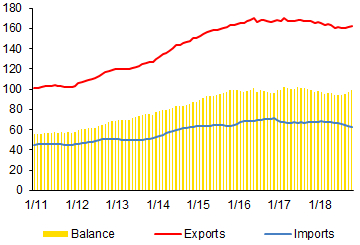The Czech Republic’s trade relations with the UK in recent years
(authors: Filip Novotný, Ladislav Prokop)
The UK Parliament’s rejection of the Brexit deal in January prolonged the period of uncertainty. The future arrangement of relations between the EU and the UK was thus still unknown. Before the vote in the UK Parliament, the European Commission had called on the EU Member States to approve legislative exemptions that would enable some aspects of the status quo to be extended even in the event of a no-deal Brexit, thereby preventing immediate adverse effects. Nonetheless, the persisting period of uncertainty started by the outcome of the Brexit referendum in mid-2016 is affecting the entire European economy. The unending period of uncertainty is naturally having a creeping negative effect on the sentiment, consumer behaviour and investment activity of UK entities and hence on UK economic growth. A disorderly Brexit would also be a strong negative economic shock to growth in the EU, including the Czech Republic. This box aims to show in this context how direct trade relations between the Czech Republic and the UK have evolved in recent years.
The UK is currently the fifth-largest trading partner for Czech exporters. However, the UK’s share in total Czech exports has shrunk compared to 2015 and amounted to 4.5% in 2018.1 Imports from the UK meanwhile accounted for just 1.8% of total Czech goods imports. Trade relations between the Czech Republic and the UK are thus very asymmetrical. This is also evidenced by the goods surplus (see Chart 1). It was increasing until the end of 2015 but has been broadly flat since the start of 2016. A similar trend applies to the services surplus, which amounted to CZK 7.8 billion in 2018,2 due mostly to the transport sub-item.
Chart 1 (BOX) Goods trade between the Czech Republic and the UK
The Czech Republic’s high trade surplus with the UK has been flat since 2016
(annual moving totals in CZK billions; under the national approach)

Goods exports to the UK have seen virtually no change in structure in recent years. In 2018, machinery and transport equipment were the most important item of both exports and imports. They made up 70% of total goods exports to the UK, with passenger cars accounting for almost one-third of that figure (CZK 45 billion in absolute terms). Machinery and transport equipment also recorded the largest surplus of all the trade categories (see Table 1); one-half of this surplus was due to a surplus for road vehicles. By contrast, chemicals recorded the widest deficit.
Table 1 (BOX) Structure of the balance of goods between the Czech Republic and the UK
The UK is a major target market for the Czech automotive industry
(cumulatively in CZK billions for the period 12/2017–11/2018; cross-border statistics)
| SITC | Exports | Imports | Balance | |
|---|---|---|---|---|
| 0 | Food and live animals | 4,0 | 3,2 | 0,9 |
| 1 | Beverages and tobacco | 0,4 | 0,8 | -0,4 |
| 2 | Crude materials except fuels | 0,8 | 0,8 | 0,0 |
| 3 | Mineral fuels and lubricants | 0,6 | 0,4 | 0,2 |
| 4 | Animal and vegetable oils | 0,0 | 0,1 | -0,1 |
| 5 | Chemicals | 6,3 | 14,8 | -8,4 |
| 6 | Manufactured goods | 23,8 | 11,2 | 12,6 |
| 7 | Machinery and transport equipment | 143,7 | 45,3 | 98,3 |
| 8 | Miscellaneous manufactured articles | 25,6 | 8,6 | 17,0 |
| 9 | Commodities not classified | 0,2 | 0,2 | -0,1 |
| Total | 205,4 | 85,5 | 120,0 |
Mutual trade is being negatively affected by the uncertainty of UK firms and households about the future situation. This is being reflected in a downturn in demand for imports to the UK and a marked depreciation of sterling against other currencies, including the Czech koruna. The UK economy grew by 2.5% a year on average in 2013–2015, faster than Germany and the USA, but its growth has slowed to 1.6% on average in three recent years.3 This is lower than in the said countries.
1 The calculation was performed using the moving total for the period from December 2017 to November 2018.
2 The calculation was performed using the moving total for the period from 2017 Q4 to 2018 Q3.
3 The growth estimate for 2018 was taken from the Economist Intelligence Unit.